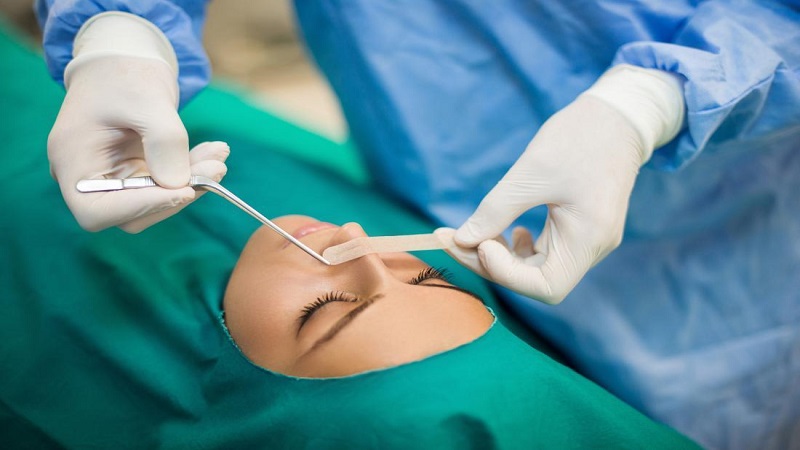(Rhinoplasty with Local Anesthesia)
Comprehensive Article on Non-Anesthesia Nose Surgery

Comprehensive Article on Non-Anesthesia Nose Surgery (Rhinoplasty with Local Anesthesia)
Introduction
Non-anesthesia nose surgery, also known as rhinoplasty with local anesthesia, is a modern method in nasal surgery that allows individuals to make desired changes to the appearance of their nose without the need for general anesthesia. This method has gained popularity among individuals seeking less invasive cosmetic procedures due to advantages such as reduced risks associated with general anesthesia, shorter recovery periods, and lower patient anxiety. This article provides a comprehensive overview of this method, reasons for choosing it, its advantages and disadvantages, surgical techniques, and post-operative care.
Understanding Non-Anesthesia Nose Surgery
Non-anesthesia nose surgery involves using local anesthesia instead of general anesthesia during nasal surgery. In local anesthesia, the targeted area (in this case, the nose) is temporarily numbed so the patient does not feel any pain during the procedure. Unlike general anesthesia, which puts the patient in a deep sleep, local anesthesia keeps the patient awake and able to respond to the surgeon while feeling no pain.
This type of surgery is mostly used for minor corrections and subtle changes to the nose and is usually suitable for individuals who do not require major structural changes. Some common non-anesthesia nasal surgeries include the removal of small bumps, improving the nasal tip, or making minor adjustments to the nasal septum. However, the decision to use local anesthesia should be based on the surgeon’s recommendation and the patient’s condition.
Reasons for Choosing Non-Anesthesia Nose Surgery
Non-anesthesia nose surgery has gained significant popularity for various reasons, including aesthetic and functional benefits, as well as reduced risks and complications associated with general anesthesia. Below are some key reasons for opting for this method:
- Reduced Risks of General Anesthesia
One of the primary reasons for choosing rhinoplasty with local anesthesia is the reduced risks associated with general anesthesia. Although general anesthesia is generally safe, it can pose additional risks for certain individuals, particularly those with heart, lung issues, or allergies to anesthesia drugs. Using local anesthesia greatly reduces these risks and makes the procedure safer. - Lower Anxiety and Stress
Many individuals experience anxiety about general anesthesia due to the fear of losing consciousness or concerns about not waking up after the procedure. With local anesthesia, patients remain awake during the surgery, which can reduce anxiety and stress. Moreover, many patients prefer being conscious during the procedure, feeling more in control of the surgery. - Shorter Recovery Period
Another advantage of non-anesthesia rhinoplasty is the shorter recovery time. Since no general anesthesia drugs, which can cause drowsiness, dizziness, and nausea post-surgery, are used, patients undergoing surgery with local anesthesia recover more quickly and can resume daily activities sooner than those who undergo surgery with general anesthesia. - Lower Costs
Rhinoplasty with local anesthesia is generally less expensive than surgery with general anesthesia since it reduces the need for anesthesia equipment and personnel. This can be appealing to individuals seeking more economical options. - Suitable for Simpler and Faster Surgeries
Non-anesthesia rhinoplasty is particularly suitable for smaller surgeries and minor corrections. Patients seeking subtle changes in their nasal appearance without the need for significant structural alterations can benefit from this method.
Surgical Methods for Non-Anesthesia Nose Surgery
Non-anesthesia nose surgery can be performed using various techniques depending on the patient’s needs and the type of changes required. Below are two main surgical techniques used in rhinoplasty with local anesthesia:
- Open Rhinoplasty
In open rhinoplasty, the surgeon makes a small incision in the columella (the base of the nose) to access the internal structure of the nose. This method allows the surgeon to make precise adjustments to the nasal bone and cartilage. Open rhinoplasty is suitable for more complex corrections, but due to the use of local anesthesia, this method may only be appropriate for smaller or moderate changes.
During this procedure, the patient remains awake, but thanks to the use of local anesthesia, they do not feel any pain. The patient may feel pressure or tension around the nose, but these sensations are not uncomfortable. - Closed Rhinoplasty
Closed rhinoplasty is another method in which all incisions are made inside the nostrils, with no external cuts. This technique is suitable for more minor corrections where full access to the nasal structure is not required.
Closed rhinoplasty with local anesthesia is often performed on patients who need limited aesthetic changes. This method offers a shorter recovery time, and because there are no external incisions, it leaves no visible scars.
Advantages and Disadvantages of Non-Anesthesia Nose Surgery
As with any surgical procedure, non-anesthesia rhinoplasty comes with its own advantages and disadvantages. Below is an analysis of these pros and cons:
Advantages
- Reduced Risks of General Anesthesia: As mentioned earlier, one of the biggest advantages of local anesthesia is the reduced risks and complications associated with general anesthesia, particularly for patients with specific medical conditions.
- Faster Recovery Time: Since general anesthesia drugs are not used, patients undergoing surgery with local anesthesia usually recover more quickly and can resume their daily activities sooner.
- Lower Costs: Non-anesthesia rhinoplasty is often less costly due to the reduced need for anesthesia equipment and staff, making it a more budget-friendly option.
- Reduced Patient Anxiety: Many patients feel safer and more relaxed undergoing surgery with local anesthesia since they remain awake and more in control of the procedure.
Disadvantages
- Limited for Major Changes: One of the disadvantages of this method is that it is not suitable for more extensive and complex nasal corrections. For surgeries requiring significant structural alterations, general anesthesia may be necessary.
- Potential Discomfort During Surgery: Although patients do not feel pain during the procedure, they may experience pressure or tension around the nose, which can be uncomfortable for some individuals.
- Not Suitable for All Patients: Non-anesthesia rhinoplasty may not be appropriate for all patients. Those requiring significant structural changes or more complex surgeries may still need general anesthesia.
Post-Operative Care for Non-Anesthesia Nose Surgery
Post-operative care is essential to ensure faster recovery and achieve optimal results. Below are some key post-surgery care tips following non-anesthesia rhinoplasty:
- Use of Cold Compresses: Applying cold compresses in the initial days after surgery can help reduce swelling and bruising. This should be done regularly to speed up recovery.
- Avoiding Strenuous Activities: Patients should avoid heavy physical activities and intense exercise for a few weeks after surgery, as such activities can increase swelling and bleeding.
- Sleeping with Head Elevated: It is recommended that patients sleep with their head elevated above the body using several pillows during the recovery period to prevent swelling.
- Avoid Sun Exposure: The skin on the nose is more sensitive after surgery, and exposure to sunlight can cause discoloration or increased swelling. It is essential to use a high-SPF sunscreen.
Results and Expectations
The results of non-anesthesia rhinoplasty are typically visible immediately after surgery, but swelling and bruising may delay the final outcome for a few weeks. Patients should expect a gradual reduction in swelling, with the final shape of the nose becoming fully apparent over time.
Additionally, patients should maintain realistic expectations for the surgery. While this method can make noticeable improvements to the appearance of the nose, it is best suited for minor adjustments, and for more significant changes, general anesthesia-based surgery may be required.
Conclusion
Non-anesthesia rhinoplasty is a modern, minimally invasive technique that allows individuals seeking subtle changes in their nasal appearance to undergo surgery without the need for general anesthesia. Due to the reduced risks of anesthesia, shorter recovery time, and lower costs, this method appeals to many patients. However, the decision to opt for this procedure should be based on the patient’s condition and the surgeon’s recommendation to ensure the best results and safety during surgery.


comment